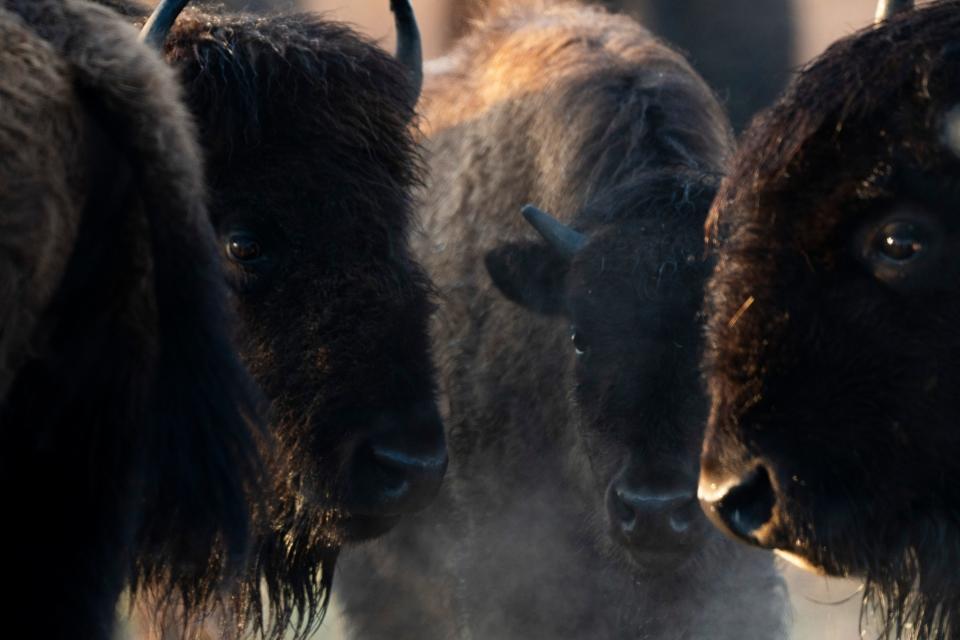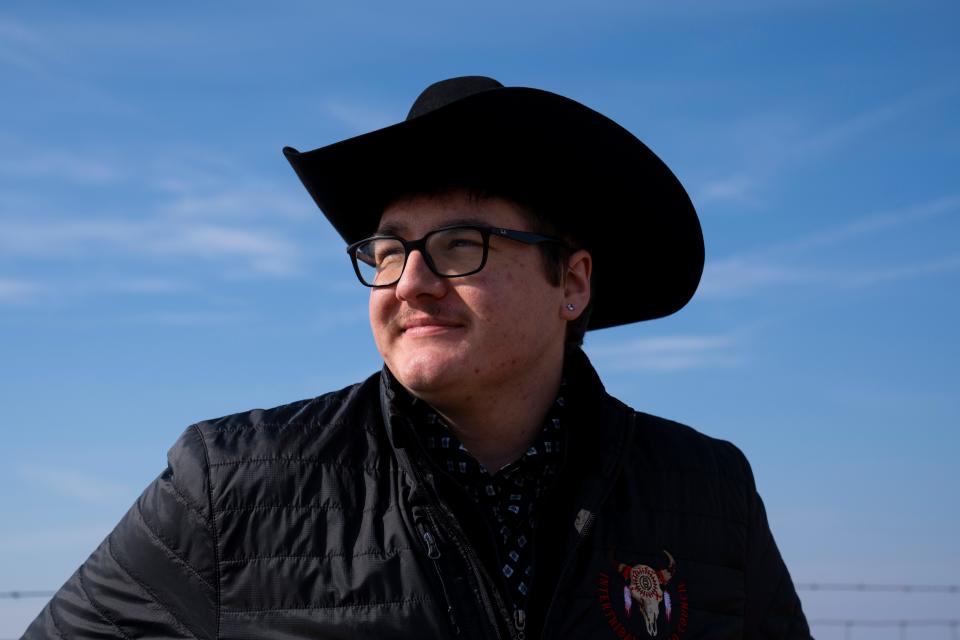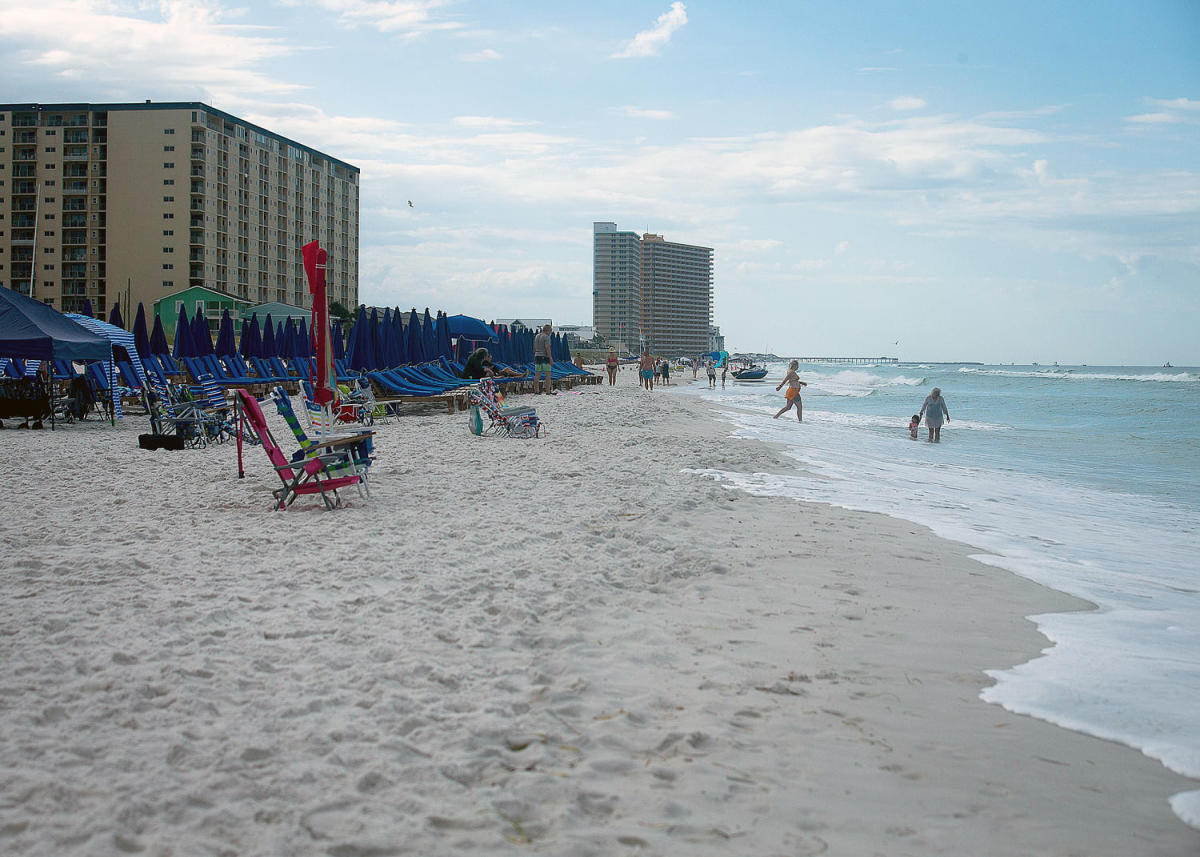A late-morning mist drifting over a herd of shaggy buffalo ambling across a quiet prairie in northwest Indiana creates an iconic scene harkening back to before Indiana became a state in 1816.
But this is 2024. And these buffalo are part of a unique project spearheaded by the Indiana chapter of The Nature Conservancy.
While the primary goal of this work by the nonprofit focused on land stewardship is to preserve and restore native habitats, the project also is helping make amends for colonialism that devastated Indigenous tribes as settlers moved west across America.
The robust herd of about nearly 90 buffalo roaming free across 1,000 acres at Kankakee Sands prairie is a rare sight today.
More than two centuries ago, however, the majestic animals were as integral to the health of the expansive grasslands across what would become Indiana as they were to the cultural identity of Indigenous tribes that lived here long before the arrival of white newcomers.
Those European settlers killed tens of millions of buffalo as they moved west across what they saw as The New World. The calculated slaughter devastated Indigenous people by snuffing out a primary source of sustenance in the vast expanse they called Turtle Island.
By the late 1800s, the killers had left only a few hundred of the continent’s largest mammal in the wild.
Buffalo project reconnecting cultures
Jason Baldes, an Eastern Shoshone, lives on the Wind River reservation in Wyoming where he’s worked for the last seven years to restore buffalo for the tribe. His work led him to the role of vice president of the Intertribal Buffalo Council, which has partnered with the TNC chapter in Indiana and others across the country.
“Buffalo restoration as land ‘rematriation’ is a way of reconciliation,” Baldes said.
He explained the patriarchy brought to North America by settlers replaced the matriarchies that some tribes modeled after buffalo herds. Rematriation involves restoring the roles of women and girls to help meet the needs of communities and comes by practicing beliefs and values “given to us by our relationship with the buffalo,” he said.
“Buffalo were our life’s commissary. We distinguished our bands by the foods we ate,” said Baldes, a member of the Buffalo Eaters band. “Buffalo have been missing from our lives for about 130 years before we were able to bring them back.”
Despite the absence of buffalo for so long, Baldes said the connection between Indigenous people and the animal remained strong. Members held onto that bond through songs and ceremonies, maintaining a cultural belief system and values “intricately tied to buffalo,” he said.

Restoring buffalo to tribal communities is about healing culture and spirit, Baldes said, a goal that also includes expanding tribal lands for buffalo habitat. But the vision extends beyond restoring prairies and buffalo herds, he said. It’s also about helping Indigenous peoples heal themselves.
Native Americans “have long experienced lower health status when compared with other Americans,” according to the federal Indian Health Service. Data show higher death rates in many categories, including diabetes mellitus and chronic lower respiratory diseases. They also have the highest premature heart attack death rates across all other populations in the U.S., according to the American Heart Association.
Baldes correlates these disparities directly to the removal of buffalo and the healthy diets his band and others depended on for generations.
“There are 574-plus tribes on this continent,” Baldes said, “and a good share of them had a relationship with the buffalo.”
The White Earth Band of Ojibwe in Minnesota recently received its first four buffalo from Kankakee Sands. Rob Tibbetts, cultural advisor with White Earth, said that while his tribe isn’t known for its relationship with buffalo, their presence is important.
“The return of bison is symbolic,” Tibbetts said, “of the return of Indigenous people.”
The tribe’s Agricultural Manager Wade Jackson said one of the objectives of introducing a herd of buffalo is to move toward food sovereignty and security.
“With the removal of land, removal of culture, removal of lifestyle, re-education, white man’s trading posts and stores, the incidence of diabetes really started to elevate toward that critical mass,” Jackson said. “The objective of our food sovereignty program has multiple folds, and one is to address that component of food health and nutrition.”
Jack Heisler, bison foreman for White Earth, was with Jackson the day the Nature Conservancy’s buffalo from Kankakee Sands were delivered. They kept the event low-key, but there was a small drum group and spiritual advisor to capture the spiritual and cultural integrity.
“It was good for the heart,” Heisler said of the day the buffalo came. “It felt good.”
There were some apprehensions as the group heard tales of buffalo running out of the trucks and right through the fencing, but Jackson said as soon as the buffalo appeared “it turned to immediate joy.”
Restoring habitat and culture in Indiana
Buffalo roamed the grasslands of what is now Indiana for centuries. Herds were so large they trampled down a well-defined path known as Buffalo Trace that cut across the northern edge of what is now the Hoosier National Forest and stretched into Illinois.
The trace was one of the first routes to appear on early maps of Indiana and the image of a buffalo jumping over a log remains a prominent feature even today on the state’s official seal.
But as settlers pressed westward following the Revolutionary War, the animals were “nearly driven to extinction through uncontrolled hunting and a U.S. policy of eradication tied to intentional harm against and control of Tribes,” according to the U.S. Department of the Interior.

In Indiana, the last wild buffalo reportedly was shot and killed in Orange County in 1830, according to the nonprofit Jasper Newton Foundation.
Today, about 200 miles north of the old Buffalo Trace, Trevor Edmonson and Olivia Schouten are working to restore a prairie at Kankakee Sands, which includes more than 8,000 acres of prairies and wetlands owned and managed by TNC’s Indiana chapter. Their efforts also support a herd of about 90 buffalo that grew from 23 animals first introduced in 2016.
The herd, descendants of buffalo from Wind Cave National Park, grazes on more than 1,000 acres of the restored prairie about an hour south of Gary.
Their presence works in tandem with the land restoration project. As the buffalo feed on the tall grasses, they provide habitat for rare birds. When they roll and wallow on the ground, they create depressions that hold water and provide habitat for amphibians and other wildlife. The habitat also creates cover from predators.
“A grassland might look kind of uniform, but there are differences,” Schouten said while driving through Kankakee Sands. “There are grasses that are tall and pretty difficult to walk through, and then you can see how the bison really thin it out and create spaces both for plants to grow, but also for different birds that have different nesting preferences.”
But the land Edmonson and Schouten are revitalizing can only sustain so many buffalo before overgrazing destroys a delicate balance. Predators once native to Indiana that might have naturally culled a herd are no longer in the state. Mountain lions were killed off in the 1800s and unregulated hunting and habitat loss also destroyed bear populations.

With no natural predators, TNC’s buffalo herd could quickly grow beyond the prairie’s capacity, so the land stewards do an annual roundup to remove some of the animals and maintain a healthy habitat.
The excess animals were initially sold off at auctions, but when Baldes and ITBC approached The Nature Conservancy about obtaining buffalo, the organization jumped at the opportunity to partner.
“We feel like that program better aligns with our conservation mission,” Edmonson said. “We recognize our bison are incredibly valued as more than just a commodity, more than just livestock, to our organization and to ITBC.”
A growing partnership breeds success
As Kankakee buffalo become ready to be transferred each fall, Thomas Peters of the Meskwaki Nation gets on his phone with TNC and various tribes to coordinate and make sure the moves go smoothly.
Peters does the field work for ITBC and travels to places like Kankakee Sands during the transfers.

“We want to find the best fit for every tribe,” he said. “We tend to send the animals to the closest tribe, but it’s good to switch it around. If we’re sending all of them from Kankakee to one tribe, that’s not enhancing the genetics at all.”
The transfers from Kankakee to tribal nations are part of a growing partnership between TNC and the buffalo council and are helping drive the largest restoration of buffalo to Indigenous peoples. The conservancy manages more than 6,000 buffalo at Kankakee and 11 other preserves throughout the U.S.
The partnership began in 2020 and includes the nonprofit Tanka Fund, which has worked for 10 years providing animals, grants and technical assistance to Native American buffalo caretakers. Since the first transfer from the Medano-Zapata Ranch Preserve in San Luis Valley of Colorado, TNC chapters have already sent more than 1,000 buffalo to native communities.
Peters and others at ITBC handle most of the logistics, including transportation, management, veterinarian costs, and other fees for moving animals across state lines. The expenses are paid through herd development grants from the federal government. ITBC also assists tribal programs with infrastructure, equipment, labor, and salaries to help with their new herds.
The buffalo council was established in 1992 with about 10 tribes and has since grown to more than 80, Baldes said. In those years, the council has restored more than 25,000 buffalo to 65 different herds in 21 states.
Tribes have applied pressure on the U.S. government to say they should have priority when it comes to obtaining buffalo, Baldes said, and organizations like TNC recognize and agree with that approach.
“Rather than auctioning the animals, they’re donated to ITBC, which we take and deliver to the member tribes that have requested access to additional animals,” Baldes said. “That gives us more diversity to pull from and ensures we have enough animals that go out to tribes.”
Building from the momentum
As the transfer program continues, Baldes said it’s meeting only about 5% of what tribes are asking for to restore their buffalo populations.
“We could really use about 10 or 12 more million to meet the need,” Baldes said.
The ITBC is currently working to gain support and momentum for the Indiana Buffalo Management Act, a bill recently reintroduced in the U.S. Senate after an earlier version died.
The act, introduced last year by Sen. Marin Heinrich (D-NM) and Markwayne Mullin (R-OK), would create a permanent program within the Department of the Interior to award more grant money, develop the capacity of tribal organizations to manage buffalo and habitat, and ensure treaty rights of tribes are not affected.
“I am proud to co-lead this important legislation that will help Tribes reestablish buffalo herds on reservation lands,” Mullin said in a statement. “Doing so ensures that native peoples across the country will continue reconnecting with a keystone of their historic culture and way of life.”
But legislation will only go so far.
Tribes also face a limit on how many buffalo they can acquire because of the lack of adequate land, Baldes said. Reservations have been drastically diminished and carved up by assimilative polices like the General Allotment Act and Baldes said it’s hard to piece land together and save the necessary habitat for larger herds.
“We had a gathering of buffalo herd managers not too long ago and that was primary message from that meeting,” Baldes said. “We can’t accept more buffalo until we have more land. How do we get that, which takes hundreds of millions of dollars to buy back, unless organizations like TNC and others in the land business can work with tribes.”
Karl Schneider is an IndyStar environment reporter. You can reach him at karl.schneider@indystar.com. Follow him on Twitter @karlstartswithk
IndyStar’s environmental reporting project is made possible through the generous support of the nonprofit Nina Mason Pulliam Charitable Trust.
This article originally appeared on Indianapolis Star: Buffalo making foothold in Indiana, providing support to native tribes
Signup bonus from




